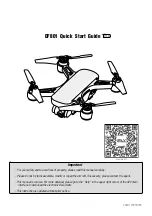
FULL USER MANUAL
GANNET 2+ / MAX +
17
16
Take off and flight
•
Always stand well clear of the drone, carbon fibre propellers can be very
dangerous and must be avoided, never try to stop spinning propellers by hand!
•
Arm the drone by touching the arm button on the bottom left of the Skydroid
screen which will turn blue and a slide control will appear in the centre of the
screen to start the motors.
•
When safe, give gradual power by increasing the throttle/elevation/Left
control stick gradually, DO NOT give rapid full throttle, the drone will take off
dangerously fast,
•
If the drone starts to move in slow circular movements it can indicate that
the compass calibration is not optimal for this position, you can land and
recalibrate it a short distance away to reduce possible interference. Also note
that Smartphones and smart watches can cause interference and should be
kept away from the drone during calibration,
•
If the circular movement is minor, momentarily switch the drone to Atti and
back to GPS, this cancels the “hunting” of the GPS and steadies the drone,
Home point remains in the original position,
•
Avoid sudden rapid or full control stick movements, gentle controlled
movements will result in a more enjoyable flight experience,
•
First low battery warning is given at 15,2V pay close attention to this. If
unloaded the drone can still fly for several minutes but best be on your way
back to land.
•
Never attempt to fly just one more bait on a low battery.
•
At 14,2V the drone will not have any more power to fly and will land/descend
where it is.
•
NEVER overload the drone, higher loads drain the battery faster, too high loads
can also damage the battery
•
When loaded keep the flight time as short as possible, fly at a steady speed and
do not waist time hovering in place unnecessarily as it will drain the battery
rapidly.
•
Do not fly in strong gusting winds unless you are an experienced pilot and even
then take care and fly with caution
•
RTH (return to home) should only be used when absolutely necessary, it is safer
to fly the drone back yourself, if it is hard to judge the orientation, switch to
home lock in which event pulling back on the right-hand control will bring the
drone closer to you regardless of the drones orientation. When you do use RTH
keep an eye on the drone to ensure that the drone is performing the command
and should it deviate, return to GPS mode so that the drone can be flown back
manually.
Warning!
If signal from the remote is lost while the drone is armed. It could take off
from the ground and climb to ‘Return To Home’ altitude before descending
again. If signal is lost due to powering off the Remote Controller. Switch the
controller back on and toggle the flight mode switch to Atti, then back to
GPS to regain control of your drone.
General warnings and care
•
Familiarize yourself with your local drone laws and abide by them at all times.
•
Do not fly near known sources of high interference, this includes Cell phone
towers, railroad lines and power lines, never calibrate the drones compass near
such a source of interference, this includes cell phones and smart watches
•
Do not unnecessarily expose the drone to water, especially salt water, although
every precaution has been made to prevent corrosion by using corrosion
resistant materials and corrosion protective coatings on the exposed parts
both internal and external, it should be noted that salt water is highly corrosive
and can in a matter of hours cause damage if not thoroughly removed and
cleaned.
•
Do not leave the drone in direct sunlight for prolonged periods, it can heat the
battery up and cause failures, it can also cause hull over pressure weakening
the seals.
•
NEVER intentionally land the drone at a distance away for you on the water,
whilst the radio communication in flight is well over 1,6km (1 Nm) it cannot be
assured that radio communication will always be maintained whilst the drone is
floating on the surface far away from you as water blocks all radio waves.
•
Motor bearings need to be lubricated regularly with a good machine oil that is
solvent free.
•
NEVER fly with cracked, chipped or damaged propellers, they can easily fail mid-
flight under load and cause a crash, if a damaged propeller is found discard it
immediately keeping only the propeller quick release,
•
If the drone has been exposed to salt water, rinse it directly after the flight with
running fresh water to wash away all salt. Dry with a cloth and lubricate the
motor bearings, both upper and lower,
•
Always disconnect the battery when packing away the drone this is to avoid
accidentally powering the drone on and discharging the battery completely,
•
If the drone stops responding to any command and just hovers in place, switch
the remote off completely, this will activate RTH and the drone should return
home unless there is severe interference preventing this,


































